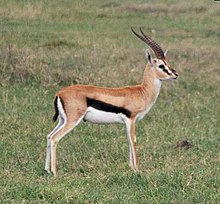Thomson Gazelle
As Thomson's gazelles are now two types of gazelle-like referred to in the East African countries Kenya and Tanzania are common. Until the beginning of the 21st century, these were still considered a single species and were led under the scientific name Eudorcas thomsonii (formerly Gazella thomsonii ). A revision of the hornbeams published by Colin Peter Groves and Peter Grubb in 2011 split the eastern from the western populations . Today, a distinction is made between the following types:
- Western Thomson's gazelle ( Eudorcas nasalis ( Lönnberg , 1908)); in Tanzania and Kenya in the Serengeti ecosystem west of the East African Rift;
- Eastern Thomson's gazelle ( Eudorcas thomsonii ( Günther , 1884)); in Kenya and Tanzania east of the East African Rift , for example from the Nairobi and Kilimanjaro regions via Arusha , the Wembere plains to Shinyanga ;
The Thomson Gazelle is named after the Scottish Africa explorer Joseph Thomson , who brought a horn from Eastern Africa to Albert Günther , who first described the Eastern Thomson Gazelle . To the west of the Thomson gazelle, in South Sudan, there is a similar form, the Mongalla gazelle ( Eudorcas albonotata ), which was sometimes regarded as a subspecies of Eudorcas thomsonii . On the other hand, the Thomson gazelle and Mongalla gazelle were occasionally considered as subspecies of the red-fronted gazelle ( Eudorcas rufifrons ).
Thomson gazelles are among the most common and probably also the best known representatives of the gazelles . They reach a head-torso length of 92 to 107 cm, a tail length of 19 to 26 cm and a shoulder height of 58 to 76 cm. The body weight varies from 17 to 24.5 kg. With the specified dimensions, they are among the smaller gazelles. Males are on average larger than females. Compared to the Western Thomson Gazelle, the Eastern Thomson Gazelle is significantly larger. Both species are characterized by a pale yellow-brown top and a whitish underside. Both areas are separated from one another by a wide, black stripe on the sides. The face is marked by a dark stripe that runs from the eyes over the cheeks and is bordered on the inside by a whitish stripe. The forehead and middle face are again dark, as is the short tail. The ears are moderately large and narrow with a length of 11 to 12 cm. Both sexes have closely spaced, curled horns. Those of the males are about 30 cm long with a record length of 44 cm. The horns of the females only reach 32 to 39% of the length of the horns of the males and are therefore significantly shorter, also slimmer and more fragile. In general, the western species differs from the eastern species by a darker dorsal fur that has a reddish tinge, more contrasting facial stripes and a more noticeable dark nasal patch.

These animals prefer open savannahs and avoid thick bushes. The animals live in herds of about sixty animals; in the Serengeti the herd size can even grow to a few thousand animals. Males are territorial and claim any female that enters their territory. They prefer to stay in regions of the Serengeti where the grass is short. This is presumably due to the fact that the shorter grass gives their predators fewer hiding spots.
Thomson's gazelles are often found in the company of Grant's gazelles and impalas . They play in the ecosystem of the Serengeti as the second most abundant ungulate after Wildebeest an important role, as they are a favorite prey of many predators are. In the Serengeti, leopards feed mainly on Thomson's gazelles. They fall prey to the cheetah in particular . However, adult animals reach speeds of 80 km / h.
Thomson gazelles can live up to ten years.
literature
- Colin Groves and Peter Grubb: Ungulate Taxonomy. Johns Hopkins University Press, 2011, pp. 1-317 (p. 175)
- Colin P. Groves and David M. Leslie Jr .: Family Bovidae (Hollow-horned Ruminants). In: Don E. Wilson and Russell A. Mittermeier (eds.): Handbook of the Mammals of the World. Volume 2: Hooved Mammals. Lynx Edicions, Barcelona 2011, ISBN 978-84-96553-77-4 , pp. 649-650
- CA Spinage: The Natural History of Antelopes . Croom Helm, London 1986, ISBN 0-7099-4441-1
Single receipts
- ↑ a b c Colin P. Groves and David M. Leslie Jr .: Family Bovidae (Hollow-horned Ruminants). In: Don E. Wilson and Russell A. Mittermeier (eds.): Handbook of the Mammals of the World. Volume 2: Hooved Mammals. Lynx Edicions, Barcelona 2011, ISBN 978-84-96553-77-4 , pp. 649-650
- ^ A b Colin Groves and Peter Grubb: Ungulate Taxonomy. Johns Hopkins University Press, 2011, pp. 1-317 (p. 175)
- ^ Albert Günther: Note on some East-African Antelopes supposed to be new. Annals and Magazine of Natural History 14, 1884, pp. 425-429 ( [1] )
- ↑ a b c Clare FitzGibbon and John Wilmshurst: Eudorcas thomsonii Thomson's Gazelle. In: Jonathan Kingdon, David Happold, Michael Hoffmann, Thomas Butynski, Meredith Happold and Jan Kalina (eds.): Mammals of Africa Volume VI. Pigs, Hippopotamuses, Chevrotain, Giraffes, Deer and Bovids. Bloomsbury, London 2013, pp. 361-369
- ↑ a b c d CA Spinage: The Natural History of Antelopes . Croom Helm, London 1986 (pp. 62, 99, 192), ISBN 0-7099-4441-1
